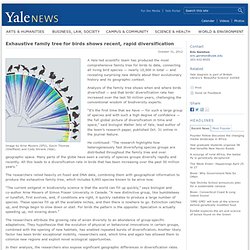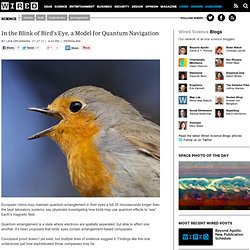

FamilyPhotos_0002. FamilyPhotos_0001. Aqutaq_Drooling. Daily Infographic: A Family Tree Of Every Bird On Earth. This gorgeous infographic is the first family tree linking every bird on Earth, revealing how birds have evolved since the dinosaur age.

The map shows where and when birds lived, which offers a glimpse of species diversification around the planet. One big takeaway: Birds have been diversifying at an increasing rate in the past 50 million years. Today, 9,993 living species are known. This is significant, because it runs counter to a prevailing view in biodiversity circles, the study's authors say. "A new distinctive group, like bumblebees or tunafish, first evolves, and, if conditions are right, it quickly radiates to produce a large number of species," says co-author Arne Mooers of Simon Fraser University in Canada.
Another surprise from the data: The greatest diversification is not in the tropics, but in the western hemisphere. The authors have a couple ideas about why this is. Exhaustive family tree for birds shows recent, rapid diversification. Image by Arne Mooers (SFU), Gavin Thomas (Sheffield) and Cody Shrank (Yale).

A Yale-led scientific team has produced the most comprehensive family tree for birds to date, connecting all living bird species — nearly 10,000 in total — and revealing surprising new details about their evolutionary history and its geographic context. Analysis of the family tree shows when and where birds diversified — and that birds’ diversification rate has increased over the last 50 million years, challenging the conventional wisdom of biodiversity experts. “It’s the first time that we have — for such a large group of species and with such a high degree of confidence — the full global picture of diversification in time and space,” said biologist Walter Jetz of Yale, lead author of the team’s research paper, published Oct. 31 online in the journal Nature.
The researchers attribute the growing rate of avian diversity to an abundance of group-specific adaptations. “This was one of the big surprises,” Jetz said. In the Blink of Bird’s Eye, a Model for Quantum Navigation. European robins may maintain quantum entanglement in their eyes a full 20 microseconds longer than the best laboratory systems, say physicists investigating how birds may use quantum effects to “see” Earth’s magnetic field.

Quantum entanglement is a state where electrons are spatially separated, but able to affect one another. It’s been proposed that birds’ eyes contain entanglement-based compasses. Conclusive proof doesn’t yet exist, but multiple lines of evidence suggest it. Findings like this one underscore just how sophisticated those compasses may be.
“How can a living system have evolved to protect a quantum state as well — no, better — than we can do in the lab with these exotic molecules?” Many animals — including not only birds, but some mammals, fish, reptiles, even crustaceans and insects — navigate by sensing the direction of Earth’s magnetic field. Research since then has revealed the existence of special optical cells containing a protein called cryptochrome. Rehome1Pet. We'll list here big humane societies, ngos, animal sanctuaries, animal shelters and a lot more ... please @ us at our twitter account EarthActivists if your ... we RT and forward it to #EAs who are happy to help ... as of June 28, 2012 some help us get the word about #pets out ... see the twitter list of that growing list, please contact us via our twitter account EarthActivists ... we'll add you within 24 hours added to make it VERY easy for you to help us #Rehome1Pet at a time ... authorize our app at authorizeRehome1Pet and into your account ... ...
To help #Rehome1Pet ... RIP Lennox ... we could not Rehome you ... but will continue to help your furry friends to find a forever home :) a few pets looking for a forever home ... please to see the details and share the info to help #Rehome1Pet at a time latest tweets we invite you to ReTweet into your twitter account ... click on the link after the text of the tweet, then RT it ... Sky Sharks: Pictures of Super-Predators Snatching Prey From the Air – National Geographic News Watch. What one-ton fish armed with rows of dagger-like teeth can lunge ten feet from the ocean to snatch its prey?

None other than the great white shark, a super-predator that has honed its killing skills over hundreds of millions of years. Husband-and-wife photography team Chris and Monique Fallows share their pictures, experiences, and insights collected over a lifetime of observing sharks and other predators in Africa. The 19 photos in the post may be enlarged by clicking on them individually. By Chris Fallows Four hundred million years ago the first sharklike fish appeared in the ocean. It was always a dream to be able to work with these super predators. Photo courtesy of Chris Fallows, www.apexpredators.com Seal Island, nestled deep into False Bay, is only 35 minutes from beautiful Cape Town. As a wildlife photographer and naturalist, it does not come much better or bigger than to have the opportunity to capture 2,000-pound flying sharks on film.
The young seals are far from defenseless. Meekah_of_scott_soto.